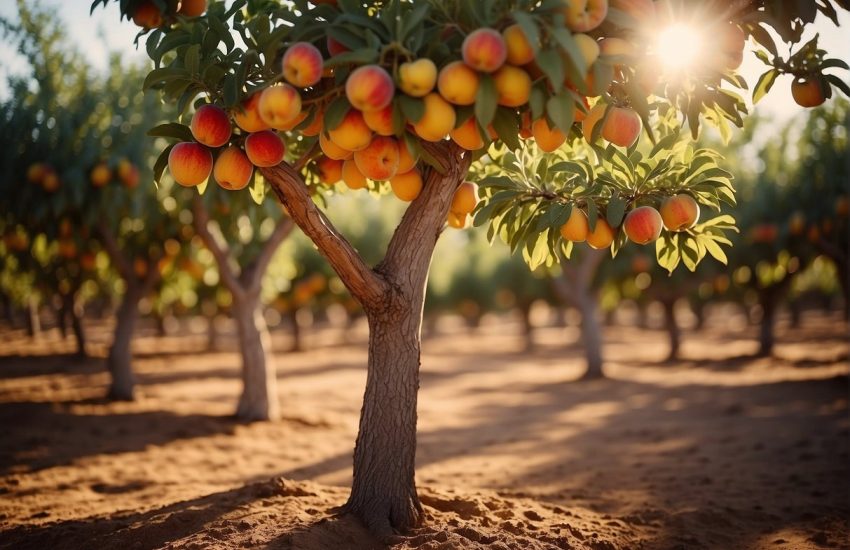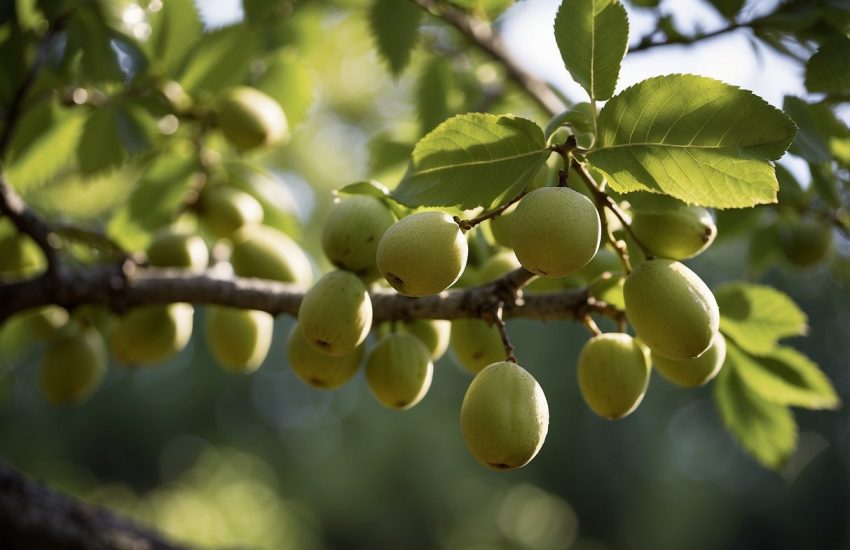5 Best Apple Trees To Grow In Southern California
Generally speaking, most apple varieties do best in a climate where there is a distinct winter period, where temperatures are around or below freezing, as well as summers in which temperatures do not exceed 90 degrees.
Southern California, on the other hand, has a “Mediterranean” climate, with long, hot, dry summers and mild winters. An important characteristic of a Mediterranean climate is that almost all of the annual rainfall occurs in winter.
In this climate, the main challenge for growing apple trees is the high summer temperatures and long growing season, which can wreak havoc on the flavor and texture of varieties that are not adapted to the climate.
Due to its mild winters, southern California is known for its low-chill climate, with fewer than 600 hours of temperatures below 40 degrees Fahrenheit per year.
It is true that low-chill varieties may be preferred for this reason, however, the lack of winter chill is more of an issue for the choice of rootstock than it is for the choice of the scion variety.
The climatic conditions in the lower chill zones have caused plants to lose vigor, and it is thought that more vigorous rootstocks are needed to compensate.
It is also important to consider that once the tree begins fruiting in this climate, it will not be able to grow much more, another reason to select vigorous rootstocks.
Fortunately, there are a number of apple varieties that are quite happy to grow in these conditions, which we have listed here for you to choose from.
If you are new to the idea of growing apples, you may be surprised to know that the climate of where an apple variety comes from is not a reliable indicator of whether it will do well in California (although apples from Australia perform consistently well). Kevin Hauser, from Kuffel Creek, gave us these recommendations and we are deeply grateful to him for doing so.
Blushing Delight™ & Golden Treat™ Columnar Urban® Apple Trees Combo
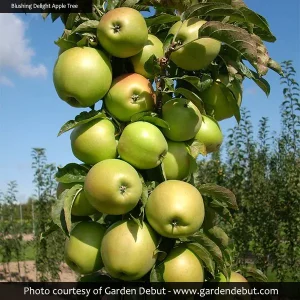
Your yard could make a beautiful statement with a few narrow columnar trees .
For a very long time in the early spring, your tree will be completely covered in white blooms.
For the rest of the summer months, you will have lush green foliage.
In the fall, you can also enjoy fresh apples.
What’s going on?
It is true that Urban Apple trees grow straight upward, not outward. When fall comes, these trees bear beautiful, delicious apples that are round and juicy.
There has never been a better time to get involved with the huge Edible Landscaping trend! For every order you make, you will receive two trees.
In addition to the Blushing DelightTM Apple tree, you will also receive a Golden TreatTM Apple tree for the price of a single tree. In your landscape, you should plant them next to each other so that they can crosspollinate each other.
We should mention that you are able to plant both of these modern columnar trees in the same amount of space that a single old-fashioned apple tree requires!
Would you like to know how it works? As the name suggests, the fruiting spurs grow very close to the main leader, rather than spreading horizontally as they do in other varieties.
Chehalis Apple Tree
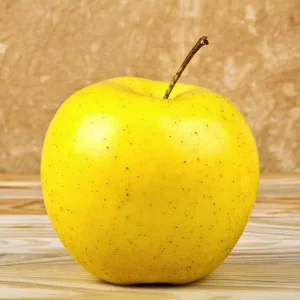
Your landscape will be more valuable with fruiting plants. The marvelous heirloom Chelalis Apple, Malus domestica ‘Chehalis,’ produces greenish-yellow apples with a hint of pink blush.
You can eat these crisp apples fresh, bake with them, and cook with them.
As a result, they are versatile, as their flavor varies depending on the time of year.
Test the ripeness of the fruit by lifting it up. You can tell they are ripe by how easily they pop off in your hand. Harvest pie apples earlier if you want them to be juicier.
Combined with other tart apples, they make fantastic pies. Whenever possible, pick ripe berries for sweeter, sub-acid taste. Applesauce can be made by letting the apples sit for a few days to soften. The apples do not need to be sweetened!
Despite its scab resistance, this heirloom variety produces clean fruit and foliage. The need for spraying chemicals is reduced. They ripen in September.
The Chehalis variety is self-pollinating. Despite being able to produce fruit on its own, it will produce more fruit with a neighboring tree nearby. If you want to grow more fruit on your land, try Liberty or Honeycrisp.
Red Custard Apple Tree
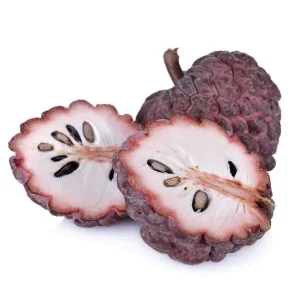
You may not know what a Custard Apple is, but once you hear this, you’ll definitely want one in your possession.
The Red Custard Apple Tree (Annona reticulata) belongs to the sweetsop family, and the tree is both a subtropical delight as well as a wonderful ornamental tree for landscaping!
They are also known as Sugar Apples or Bullock’s Hearts, these unique exotic fruits display a red rind and curious scale-like indentations on the surface of their skin.
The pointed apples in the tree seem to dangle among the tall, tropical green foliage, suspended from the branches.
It’s summer blooms of greenish-yellow are a major attraction for pollinators and for people alike, not to mention that it’s a very rare specimen tree.
Harvest this delicious and healthy fruit once it has ripened on the trees and it is ready to be picked for its custardy flesh.
You can eat it fresh, add it to baked goods or breakfast smoothies, or churn it up into an ice cream with a unique flavor!
Depending on the variety, the pulp’s color can also vary, as well as the flavor of the fruit, but when allowed to ripen on the tree, it is delicious and aromatic!
Sundowner Apple Tree
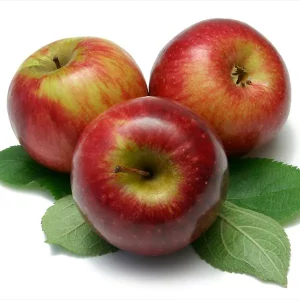
If you crave fresh, crisp apples, but you live in an area with the warmest hardiness zones… this variety is a brilliant choice.
A productive, late season tree that produces apples is the Sundowner Apple (Malus ‘Cripps II’).
This beautiful fruit originated in Western Australia and doesn’t require a long period of dormancy during the winter season. During long, warm summers, it thrives!
In addition to providing a lovely spring flower display, it also requires pollination partners to thrive. You can also try your hand at high-density planting by creating a mini-orchard.
The “learning curve” for this productive Apple tree will be well worth it! There are plenty of great-tasting, sweet apples on the Sundowner Apple Tree in the fall and early winter.
It produces medium-sized fruits that have a bicolor red skin and green background. Red may deepen over green depending on how much sunlight it receives.
Given that one of the parents is Golden Delicious, and Pink Lady is a sibling, you can imagine the taste of honey that’s spiced and hints of berries. When stored, the taste intensifies.
Gibson Yellow Delicious Apple Tree
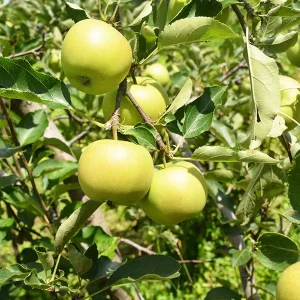
On a fall morning, would you like to look out your window and see deer standing up to pluck tasty apples from your apple tree?
The Gibson Yellow Delicious (Malus domestica ‘Gibson Yellow Delicious) can help you achieve that.
The Gibson Yellow Delicious produces plenty of large, green to golden yellow fruit, enough for your family, but still enough for the wildlife.
These trees are easy to grow and mature quickly, and they grow well in a wide range of climate zones.
It produces a large crop between late September and mid-October, and tends to russet (brown dense skin scarring) less than most golden delicious varieties. There will be a lot of apples available over the holiday season.
The greenish-yellow to golden skin of the Gibson Yellow Delicious apples is smooth and round. During most of the winter months, they will keep well, providing you with tasty snacks, and you can use them for cooking, baking, and canning.
McIntosh Apple Tree
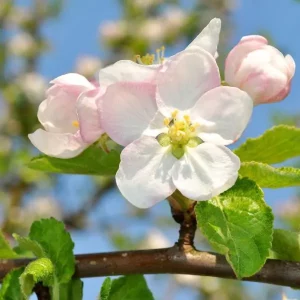
Rather than crunch, McIntosh apples are famous for their snap. As you bite into the MacIntosh, you will find the perfect combination of tartness to sugar that makes it so popular from the very first bite.
Around mid-September, the McIntosh Apple tree produces heavy crops of small to medium-sized apples that ripen and are ready for harvest.
This tree is hardy and can easily withstand cold temperatures, so McIntosh Apple crops often persist into early winter.
In addition to being cold-hardy, it’s also adapted to a variety of climates. Studies have also concluded that McIntosh requires little chilling.
There have been reports of fruit sets in zones 10 and 11a that are considered extremely low chill zones.
In spring, the McIntosh tree blooms with delicate apple blossoms, making it a beautiful addition to any yard. When the apples start to develop, you’ll enjoy watching your fruit transition into red over green, decorating the tree amongst the vibrant dark green leaves.

